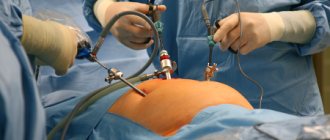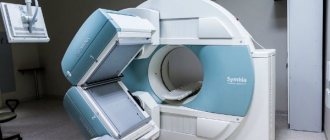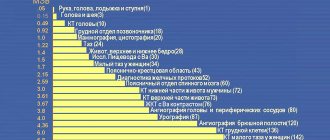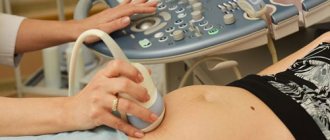Characteristics of the procedure
Ultrasound is a diagnostic method based on ultrasonic waves. They are not perceived by human senses. Ultrasound is capable of penetrating tissue and being reflected from it. Using a computer, the reflected signal is converted into an image of the organ being examined.
Ultrasound is actively used to diagnose heart diseases of various types. An ultrasound can show inflammatory processes, malformations, and rhythm disturbances. The concepts of cardiac ultrasound and echocardiogram are identical; they are the same study.
For children, only one method of echocardiography is used - transthoracic. The examination is carried out through the chest wall. There is also transesophageal echocardiography of the heart, when the sensor is inserted into the esophagus. This method is used extremely rarely in children.
An examination option is Doppler sonography. Using ultrasonic waves, they study the characteristics of blood flow through the vessels and identify obstacles.
The earliest ultrasound diagnosis can be considered an examination of a pregnant woman. Using ultrasound, you can hear the fetal heartbeat and see congenital defects.
Watch a video about ultrasound examination of the heart in children:
What is cardiac echocardiography
Ultrasound scanning of the heart, or EchoCG, is a type of instrumental study during which all parts of the heart and great vessels are displayed on the screen of a special device in different planes. Echocardiography shows whether the organ is correctly formed, confirms or excludes abnormalities in the development of the cardiovascular system, and assesses the state of myocardial and valvular function.
Types of research
In most cases, echocardiography is performed through the anterior chest wall, which is why this approach is called transthoracic. There are several types of research:
- One-dimensional echocardiography (M-mode). In this case, the scanning is carried out only along one axis, and instead of an image of the heart, an echocardiogram is displayed on the device’s screen - a layer-by-layer structure of the organ’s chambers in the form of a graph. In M-mode, the doctor can obtain information about the size of the ventricles and atria, the thickness of the myocardium and valves. Currently, this type of research is not used in isolation, but only in combination with others.
- Two-dimensional echocardiography (B-mode) provides a grey-scale image of the organ thanks to scanning in two planes in real time. During this procedure, the work of the heart is clearly visualized: contraction and relaxation of the myocardium, opening and closing of valve leaflets, contraction of blood vessels. B-mode allows you to evaluate the size of the organ, the thickness of its walls, mobility and structure of the valves.
- Doppler echocardiography is a type of study that is performed simultaneously with two-dimensional scanning. Its distinctive feature is that, thanks to the Doppler mode, normal and pathological blood flow in the heart cavity is colored in various shades (from green to bright red). The main benefit of the method is the identification of abnormal holes in the walls of the myocardium and between the vessels, registration of pathological regurgitation of blood through the lumen of the heart valves.
- Contrast echocardiography . Such an ultrasound of the heart is prescribed to a child extremely rarely, due to the fact that a special contrast is introduced into the systemic bloodstream. With its help, all cavity structures of the organ are stained, and the scanning itself is carried out according to a standard algorithm.
- Stress echocardiography means that an ultrasound scan of the heart is not performed at rest, but during physical activity. The technique allows you to detect hidden pathology in its early stages.
- Transesophageal echocardiography . This type of study is carried out not through the chest wall, but with the help of a special sensor, which is inserted through the throat into the lumen of the esophagus. The technique is performed only in specialized departments with the presence of an appropriate specialist, and only according to strict indications (suspicion of the presence of blood clots, aneurysms, control over the operated heart, etc.).
In young children and adolescents, transthoracic two-dimensional Doppler scanning is most often used.
Indications and contraindications for use
In childhood, cardiac ultrasound is performed as a screening method. Screening is a preventive examination of healthy people from risk groups for the purpose of early detection of diseases. It is indicated for newborns, children before entering school, and adolescents.
Heart ultrasound is used in an infant to confirm the diagnosis if the doctor suspects any disease. The following symptoms indicate cardiac pathology:
- increased fatigue, in a newborn it is manifested by low motor activity;
- decreased appetite, newborns refuse the breast or bottle of milk;
- cyanosis of fingertips, earlobes;
- persistent dry cough;
- poor weight gain and height;
- dyspnea;
- episodes of sudden loss of consciousness.
The doctor sends the child for ultrasound diagnostics if changes in the electrocardiogram are detected.
Ultrasound examination is safe for the human body at any age. There are no contraindications to ultrasound, with the exception of severe skin lesions on the chest. But in infants such conditions are extremely rare.
Preparation rules
There are no difficulties in preparing for ultrasound diagnostics for a child. Since the examination is most often performed transthoracically, there is no need to follow a diet.
Before the ultrasound, the child can eat his usual meals and drink water. It is recommended to feed the baby immediately before the examination. If the child falls asleep, it will be easier to examine him.
You can take a toy or book with you to distract your baby while he is being examined. When preparing for the study, older children should be explained that it will not hurt, and the diagnosis will not take much time.
How to do an ultrasound
Echocardiography is a simple and painless procedure. An ultrasound machine consists of an ultrasound source and a transducer that detects the reflected waves. It is connected to a computer, which converts the waves into an image.
Newborns
An ultrasound of the heart of a newborn baby is recommended to be done in the presence of the mother. The baby is held in his arms so that he does not spin. If the child eats before the examination begins, he will fall asleep and easily tolerate the procedure.
The doctor lubricates the baby's chest with a special sound-conducting gel. Then, using a sensor, it examines all parts of the heart and adjacent vessels.
Older children
Children after one year of age can do the examination without their mother. The child is placed on his back or left side. The doctor lubricates the baby's chest with a special gel. The inspection is carried out by a sensor.
Doppler ultrasound is performed without any additional manipulations. This is an addition to the main examination and takes 10-15 minutes.
Watch a practical video of a child’s appointment with an ultrasound diagnostic specialist:
Is frequent ultrasound examination harmful?
Sometimes, in order to make a correct diagnosis, it is necessary to carry out several diagnostic procedures, or the woman is prescribed a full examination:
- mammary glands;
- thyroid gland;
- pelvic organs;
- kidney;
- inguinal lymph nodes;
- vaginas.
The time spent in the ultrasound doctor's office may take 1 hour or more. This does not affect your health. Changes in well-being may be associated with dieting: weakness, fatigue or dizziness.
Obtained results
The result of the examination depends on the indications for which it was carried out. Screening ultrasounds of the heart usually show a healthy organ. If there are complaints, the examination reveals various diseases.
The following indicators are looked at on ultrasound:
- organ size and weight;
- sizes of the heart chambers - atria and ventricles;
- condition of the heart valves;
- diameter and lumen of blood vessels.
In the picture, the heart looks like a dark round spot with light contours. The dark areas are the cavities of the heart. Light contours are its walls, interventricular and interatrial septa.
The normal cardiac ultrasound in young children is determined by several criteria, which are presented in the table:
| Inspected area | Normal indicators |
| Left ventricle | Up to a year - 16-24 mm; 5-6 years - 34-51 mm |
| Left atrium | 10-19 mm; 19-32 mm |
| Muscle wall thickness | 9-18 mm; 21-35 mm |
| Aortic diameter | 9-15 mm; 15-30 mm |
| Volume of blood ejected from the left ventricle per minute | 65-75%; 55-60% |
Preventive ultrasound of the heart is prescribed at 1 month of a child’s life, then at 6-7 years.
What does ultrasound show in diseases?
Ultrasound, unlike a cardiogram, detects almost all heart diseases.
- A common heart defect in newborns is a patent foramen ovale. This hole in the interatrial septum should close by one year. If this does not happen, a defect is diagnosed. In the photo it looks like a dark round spot in a light partition.
- Mitral valve stenosis. Narrowing of the opening between the left heart chambers. The image shows a decrease in the dark space between the light partitions.
- Aortic valve stenosis. Narrowing of the junction between the left ventricle and the aorta. The image shows a decrease in the dark hole between the light walls of the ventricle and aorta.
- Endocarditis. Inflammation of the inner lining of an organ. The image shows a thickening of the light outline inside the chambers of the heart.
- Myocarditis. Inflammation of the muscle layer of the organ. The width of the light heart wall increases.
- Heart tumor. A dark spot is found in the chambers or on the surface of the organ.
A pediatrician interprets the results of cardiac ultrasound in children. The specialist who examines the baby writes only a conclusion about the condition of the organ seen. Interpretation of the results should be carried out taking into account data from other diagnostic methods that only a pediatrician has.
What procedure is needed to make a diagnosis, ECG or ultrasound of the heart, is also decided by the pediatrician. An ultrasound will not show cardiac arrhythmia, but a cardiogram will reveal it.
How often the test can be done depends on the disease. Some pathologies, such as severe defects, require monthly examinations. Annual monitoring is usually sufficient.
Effect of equipment on the body
To understand how often you can do an ultrasound of the abdominal organs, it is important to understand the mechanism of the procedure. The transducer transmits high-frequency sound waves through the skin. Then the waves are reflected from soft tissues, structures, and neoplasms. Depending on the density of the organ, the doctor can select a certain frequency of waves, which are subsequently converted into electrical impulses and create a moving image displayed on the screen.
During preventive examinations, a classic 2D ultrasound is usually performed. During the examination, the lowest wave frequency is used, which spreads over a fairly large area of the body and causes minimal heating. A classic black and white ultrasound can be done several times a year without any problems.
3D and 4D scanning is usually only available in private clinics. 3D ultrasound converts areas of 2D images into a three-dimensional image. Thus, the intensity of the ultrasonic waves affecting the body will be higher, but only for a few seconds. 4D ultrasound produces moving images.
The waves affecting the body have an even higher power output. Therefore, the answer to the question whether it is harmful to do frequent abdominal ultrasound also depends on the type. 3D and 4D scanning is a little more dangerous than classic scanning, but also generally does not harm a healthy person.
Important! Doctors strongly advise against doing 4D scanning in the first trimester of pregnancy. The heat from the sensor can cause obvious discomfort to the fetus.
Separately, it is worth considering ultrasound with Doppler, which is usually prescribed for examining the vessels of the kidneys, liver and other organs of the abdominal region. During such a scan, the body is exposed to an ultrasound beam concentrated in one area. This can significantly increase the local temperature, which theoretically has a negative effect on neoplasms.
Doppler is also contraindicated in the first 10 weeks of pregnancy. In any case, Doppler ultrasound is prescribed to examine blood flow, which means the blood will naturally cool down by moving through the vessels. Some modern devices automatically reduce the power of ultrasonic waves during Doppler operation to reduce the intensity of heating.
Ultrasound cost
You can have your child have an ultrasound of the heart at your local clinic or any private medical center. Clinics provide examinations free of charge upon referral from a pediatrician.
The cost of a paid examination depends on its volume - examination of only the heart or additional examination of blood vessels:
| City | Price, rubles |
| Moscow | 300-2500 |
| Saint Petersburg | 400-2500 |
| Ekaterinburg | 350-3000 |
| Novosibirsk | 450-3000 |
| average cost | 375-2750 |
Echocardiography is performed on healthy children for preventive examination or confirmation of the suspected diagnosis in patients. The procedure is safe for children's health and can be easily tolerated at any age. They do it for free at your place of residence or in private centers for a relatively low cost.
Share your experience about undergoing cardiac ultrasound, leave comments. Tell your friends what you read. All the best.
Up ▲ — Reader reviews (2) — Write a review ▼ — Print version
November 18, 2020, 20:33:12[/td]
| Yuri | |
| city: Kursk | |
Okay, then let the respected ultrasound doctor explain how to undergo ultrasound diagnostics at a lower cost. After all, even when undergoing the so-called “Medical examination”, they do not prescribe diagnostics. You have to pay for everything in different centers. They found out that I had a heart attack on my legs, and I waited for 2 whole months to undergo a heart ultrasound under the POLICY for free. But what about that? writing is disgusting. It’s one thing on paper, another thing in life.
| Vladimir | 19 November 2020, 16:44:11 |
| city: Kursk | |
Why then is ultrasound excluded from clinical examination from 2020? To save money?











